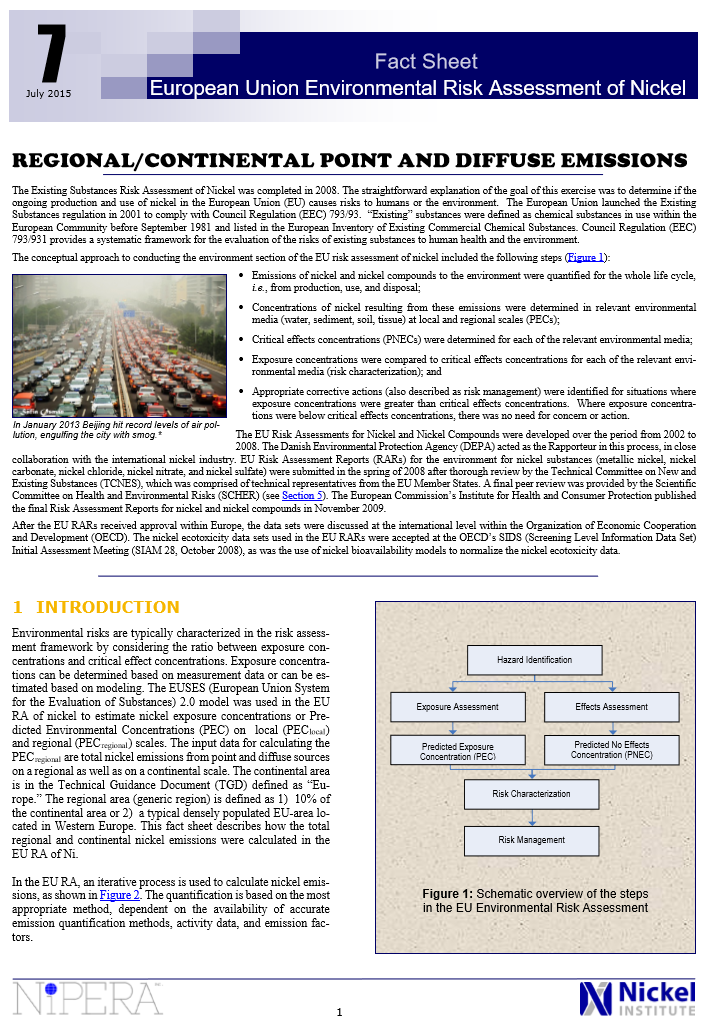2.1 IDENTIFICATION OF RELEVANT SOURCES
A first step in the development of the nickel emission inventory report is the identification of the sources of nickel that could result in releases to the environment. A long-list of potential emission sources is developed, based on an overview of the mass-flow of nickel.
The next step is the identification of the uses in which nickel could be released in the environment (air, surface water, soil). This evaluation is based the components listed below.
1. Assessment of existing emission databases (national and international):
• Pollutant Release and Transfer Registers from different countries
• International organizations developing and publishing emission inventories [e.g., EPER (European Pollutant Emission Register), E-PRTR (The European Pollutant Release and Transfer Register), HELCOM (the Helsinki Commission), OSPAR (the Oslo and Paris Convention), International Conference for the Protection of the Rhine, etc.]
• Inventory reports from other institutions/organizations
2. Experts from relevant stakeholder organizations
3. Assessment of available emission inventory guidelines:
• EMEP/CORINAIR (European Monitoring and Evaluation Programme/Core Inventory of Air Emissions) emission inventory guideline (EEA, 2009)
• AP42 Compilation of Air Pollutant Emission Factors (US EPA, 1995)
• Guidelines for the emission inventory in The Netherlands (http://www.emissieregistratie.nl, last accessed September 2013)
• Australian emission inventory guidebook (http://www.npi.gov.au/resource/national-pollutant-inventory-guide, last accessed September 2013)
4. Open literature
The outcome of this step is the identification of a list of emission sources, which are categorized in different groups (Table 1).
2.2 SELECTION OF APPROPRIATE EMISSION QUANTIFICATION METHODS
The next step in the development of an emission inventory report is to quantify emissions using a tiered approach, depending on the availability of the data. The following tiers are employed:
- A detailed approach in which emissions are based on measured or modeled data.
- A mid-tier approach in which emissions are calculated with the basic equation: E = A x EF (see Text Box 1).
- A pragmatic approach where emissions are estimated as an extrapolation of data available or calculated for another region/scale.
In the detailed approach, emissions are measured or modeled, for instance, plant individual reporting of industrial emissions to E-PRTR or emission quantified based on a detailed sewage system model or road traffic model.
In the mid-tier approach, the basic equation (Text Box 1) comes from general guidance documents on setting up emission inventory reports, like EMEP/CORINAIR emission inventory guidebook (EEA, 2009).
|
Text Box 1
Tiered Approach to Quantify Emissions
E = A x EF x CF x DF
Where:
E = Emissions
A = Activity Data, expresses the extent to which a human activity takes place
EF = Emission Factor, the coefficient that quantifies the emission or removals of a metal/product/debris per unit of activity
CF = Concentration Factor, the concentration of the metal in the
product/debris
DF = Distribution Factor, the share emitted to different Distribution Factor distribution channels (surface water, air, soil, wastewater)
|
|
The pragmatic approach was used in cases where the activity data (e.g., fuel consumption, mileage, etc.) used in the mid-tier approach were not available for the region/scale for which an inventory needs to be developed. In such case, a linear relationship was assumed between the emission sources in question and another well-defined parameter. For instance, a linear relationship could be assumed between the emissions from marine shipping allocated to a specific port and the gross tonnage of goods transferred in that port instead of the fuel consumption (which is not available).
2.3 GATHERING OF DATA
The availability of data is the limiting factor for selection of the most appropriate emission quantification methods (e.g., detailed approach, mid-tier approach, pragmatic approach). Emission data (E), activity data (A), emission factors (EF), concentration factors (CF), and distribution factors (DF) were gathered from different sources:
- individual contact with emission inventory responsible in different EU countries;
- information/reports from international organizations and data-bases, such as the European Commission, the E-PRTR data-base, North Sea Conferences, OSPAR, HELCOM, ICPR (International Conference for the Protection of the Rhine), and EMEP/CORINAIR emission inventory guidelines;
- close cooperation of industry experts; and
- the open literature.
2.4 QUANTIFICATION OF EMISSIONS
Emissions of nickel are influenced by many dynamic factors, including production techniques, different fuel sources, and ranges of pollution controls. The variability of these factors spatially across the EU and over time make it difficult to quantify emissions with accuracy. Emissions are therefore estimated according to the approach described in Text Box 1. The quality of these variables can vary extensively, and quality codes were assigned to each variable according to internationally recognized protocols.
The overall assessment of the method is determined by the lowest quality score, given to the different parameters (activity, emission factor, distribution factor) used in the method. Based on this assessment, sources and quantification methodologies for which a targeted assessment is necessary (because of their importance and/or low quality quantification method) were identified. Ultimately, the quantification method with the highest quality score is selected for each source.
As an example, we can refer to Table 2, in which an overview is given of all methods used for each identified nickel emission source, to quantify the emissions. For the source entitled “residential heating” (located under the “Households” category in Table 2) a mid-tier approach was used based on the equation:
E = A x EF, where
E = Emission
A = Activity (fuel consumption for residential heating)
EF = Emission Factor (e.g., 0.07 g nickel/ton solid fuel used)

